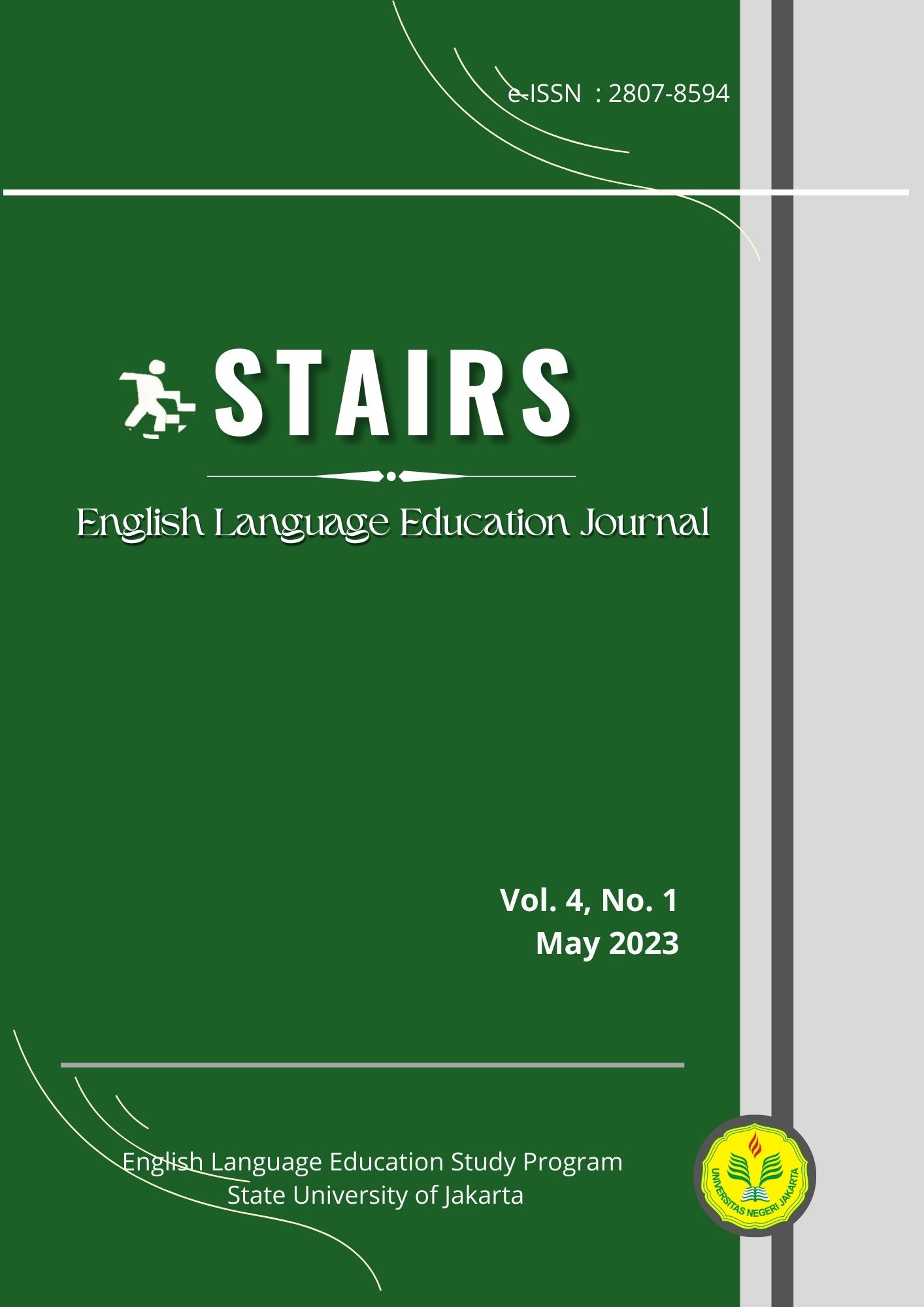The Forms of Citation Practices in the Undergraduate Students’ Theses in English Language Teaching
DOI:
https://doi.org/10.21009/stairs.4.1.2Keywords:
Citation forms, Citation Practice, Corpus analysis, Undergraduate students’ thesesAbstract
This study aims to find out the forms used in citation practices of ELESP undergraduate students’ theses at Universitas Negeri Jakarta. This research uses both quantitative and qualitative methods, which employ a corpus-based analysis. The analysis is conducted by adopting Hyland (1999)’s framework of citation category and citation integration as proposed by Swales (1990). The data source of this research consists of 50 theses in English Language Teaching (ELT), especially the introduction and literature review chapters, written by ELESP undergraduate students published from 2018 to 2022 in the repository of UNJ. The results revealed that ELESP undergraduate students frequently use summary and generalization in the introduction and literature review chapter. Furthermore, the use of integral and non-integral forms in the two chapters have nearly the same frequency, which indicates that the students focus on the actions of researchers as well as emphasize the research itself in the cited sources.
References
Ädel, A., & Garretson, G. (2006). Citation practices across disciplines: The case of proficient student writing. In M. C. Pérez-Llantada Auría, R. Pló Alastrué, & C. P. Neumann (Eds.), 27 Academic and professional communication in the 21st century: Genres and rhetoric in the construction of disciplinary knowledge (pp. 271-280). Zaragoza, Spain: Prensas Universitarias.
Aksnes, D. W., Langfeldt, L., & Wouters, P. (2019). Citations, citation indicators, and research quality: An overview of basic concepts and theories. Sage Open, 1-17. DOI: 10.1177/2158244019829575
Badenhorst, C. (2018). Citation practices of postgraduate students writing literature reviews. London Review of Education, 16(1), 121-135. DOI: https://doi.org/10.18546/LRE.16.1.11
Clugston, M. (2008). An analysis of citation forms in health science journals. Journal of Academic Language and Learning, 2, 11–22.
Cresswell, J. W. (2012). Educational research: planning, conducting, and evaluating quantitative and qualitative research. Boston: Pearson.
Harwood, N. (2009). An interview-based study of the functions of citations in academic writing across two disciplines. Journal of Pragmatics, 41(3), 497–518. https://doi.org/10.1016/j.pragma.2008.06.001
Hirvela, A., & Du, Q. (2013). “Why am I paraphrasing?”: Undergraduate ESL writers’ engagement with source-based academic writing and reading. Journal of English for Specific Purposes, 12(2), 87–98. https:// doi.org/http://dx.doi.org/10.1016/j.jeap.2012.11.005
Howard, R. M. (1999). The new abolitionism comes to plagiarism. In L. Buranen & A. Roy (Eds.), Perspectives on plagiarism and intellectual property in a postmodern world (pp. 87–95). State University of New York Press
Hyland, K. & Jiang, F. (2017). Points of reference: Changing patterns of academic citation. Applied Linguistics, 1–23. doi:10.1093/applin/amx012
Hyland, K. (1999). Academic attribution: Citation and the construction of disciplinary knowledge. Applied Linguistics, 20(3), 341–367. http://dx.doi.org/10.1093/applin/ 20.3.341
Hyland, K. (2002). Activity and evaluation: Reporting practices in academic writing. In J. Flowerdew (ED) Academic Discourse. London, Longman. PP 115-30.
Jalilifar, A., & Dabbi, R. (2012). Citation in qpplied linguistics: Analysis of introduction sections of Iranian master's theses. Linguistik online, 57(7), 91104.
Kafes, H. (2017). Citation practices among novice and expert academic writers. Education and Science, 42(192), 441-462.
Lee, J. J., Hitchcock, C., & Elliott, J. C. (2018). Citation practices of L2 university students in first-year writing: Form, function, and stance. Journal of English for Academic Purposes, 33(1), 1–11. https://doi.org/10. 1016/j.jeap.2018.01.001
Li, Y., & Casanave, C. (2012). Two first-year students’ strategies for writing from sources: Patchwriting or plagiarism? Journal of Second Language Writing, 21 (2), 165-180. https://doi.org/165-180.http://dx.doi. org/10.1016/j.jslw.2012.03.002
Liu, M., & Wu, Y. (2020). Chinese undergraduate EFL learners’ perceptions of Plagiarism and use of citations in course papers. Cogent Education, 7(1), 1-14. https://doi.org/10.1080/2331186X.2020.1855769
Loan, N. T. T., & Pramoolsook, I. (2016). Citations in the literature review chapter of TESOL master’s theses by Vietnamese postgraduates. Journal of Language Studies, 16(2), 17-32.
Mansourizadeh, K., & Ahmad, U. K. (2011). Citation practices among non-native expert and novice scientific writers. Journal of English for Academic Purposes, 10(3), 152–161. https://doi.org/10.1016/j.jeap.2011.03.004
Monreal, C. S, & Gil Salom, L. G. (2011). A cross-language study on citation practice in Ph.D. theses. International Journal of English Studies, 11(2), 53–75. https://doi.org/10.6018/ijes/2011/2/149641
Pecorari, D. (2003). Good and original: Plagiarism and patchwriting in academic second-language writing. Journal of Second Language Writing, 12(4), 317–345. https://doi.org/10.1016/j.jslw.2003.08.004
Petrić, B. (2007). Rhetorical functions of citations in high- and low-rated master’s theses. Journal of English for Academic Purposes, 6, 238–253.
Petrić, B., & Harwood, N. (2013). Task requirements, task representation, and self-reported citation functions: An exploratory study of a successful L2 student’s writing. Journal of English for Academic Purposes, 12 (2), 110–124. https://doi.org/http://dx.doi.org/10. 1016/j.jeap.2013.01.002
Samraj, B. (2013). Form and function of citations in discussion sections of master’s theses and research articles. Journal of English for Academic Purposes, 12(4), 299-310. https://doi.org/10.1016/j.jeap.2013.09.001
Swales, J. M. (1990). Genre analysis: English in academic and research settings. Cambridge: Cambridge University Press.
Swales, J. M. (2014). Variation in citational practice in a corpus of student biology papers: From parenthetical plonking to intertextual storytelling. Written Communication 31, 118–41.
Thompson, P., & Tribble, C. (2001). Looking at citations: Using corpora in English for academic purposes. Language Learning and Technology, 5, 91-105. The University of Southern California. (2022). Organizing Your Social Sciences Research Paper. Retrieved July 6, 2022, from https://libguides.usc.edu/writingguide/CARS
Wette, R. (2017). Source text use by undergraduate post-novice L2 writers in disciplinary assignments: Progress and ongoing challenges. Journal of Second Language Writing, 37(1), 46–58. https://doi.org/10. 1016/j.jslw.2017.05.015



